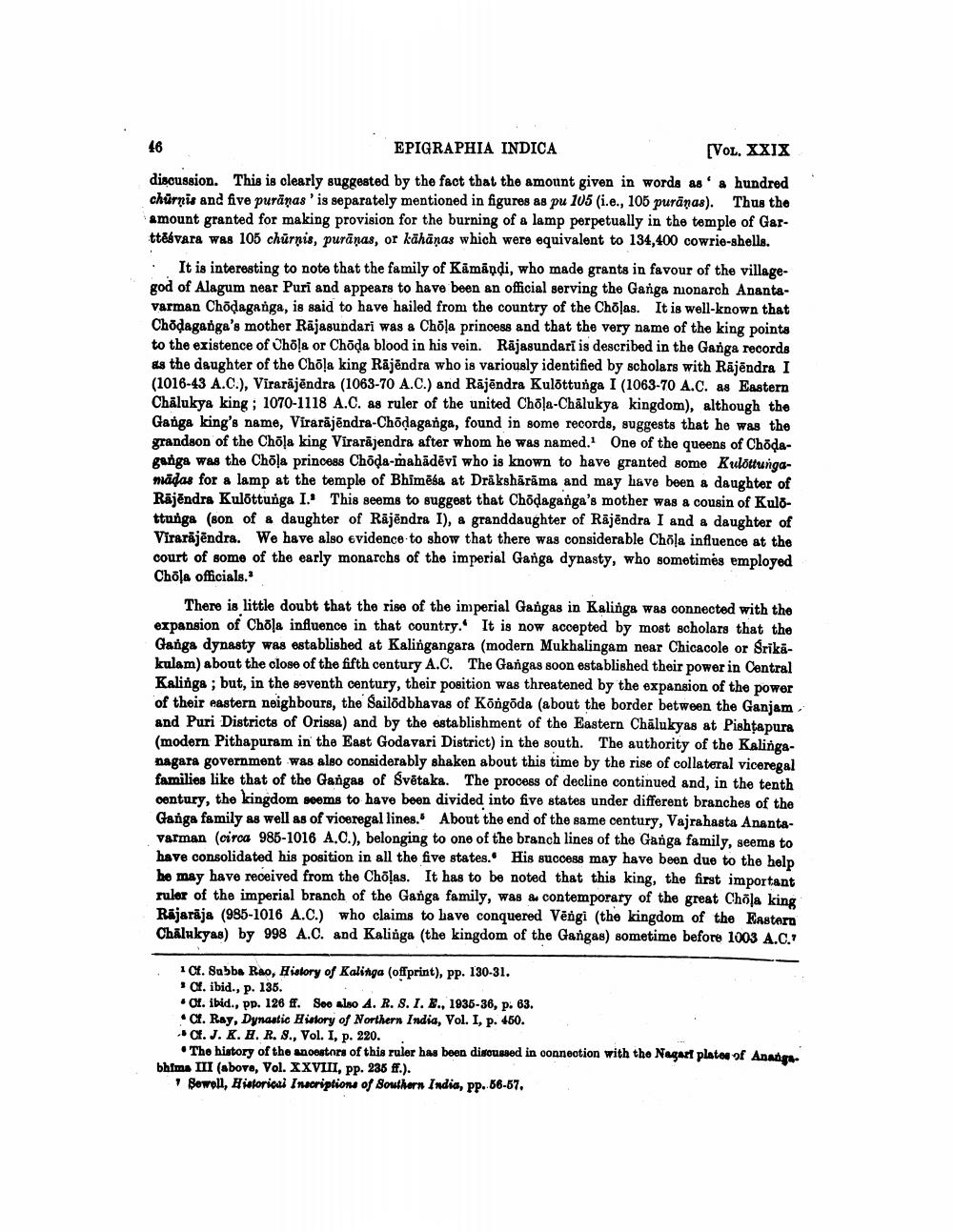________________
EPIGRAPHIA INDICA
[VoL. XXIX discussion. This is clearly suggested by the fact that the amount given in words as a hundred chürnis and five puränas ' is separately mentioned in figures as pu 105 (i.e., 105 purānas). Thus the amount granted for making provision for the burning of a lamp perpetually in the temple of Garttesvara was 105 chūrnis, purānas, or kāhāņas which were equivalent to 134,400 cowrie-shells. • It is interesting to note that the family of Kāmāņdi, who made grants in favour of the villagegod of Alagum near Puri and appears to have been an official serving the Ganga nionarch Anantavarman Chodaganga, is said to have hailed from the country of the Cholas. It is well-known that Chodaganga's mother Rājasundari was a Chöļa princess and that the very name of the king points to the existence of Chola or Chöda blood in his vein. Rājasundarf is described in the Ganga records as the daughter of the Chāļa king Rājēndra who is variously identified by scholars with Rājēndra I (1016-43 A.C.), Virarijëndra (1063-70 A.C.) and Rājēndra Kulottunga I (1063-70 A.C. as Eastern Chalukya king : 1070-1118 A.C. as ruler of the united Chola-Chalukya kingdom), although the Ganga king's name, Virarājēndra-Chodaganga, found in some records, suggests that he was the grandson of the Chola king Virarājendra after whom he was named. One of the queens of Chödaganga was the Chola princess Chōda-mahādēvi who is known to have granted some Kulottungamādas for a lamp at the temple of Bhimēsa at Dräkshärama and may have been a daughter of Rajendra Kulottunga I.. This seems to suggest that Chodaganga's mother was a cousin of Kulottunga (son of a daughter of Rājēndra I), a granddaughter of Rājēndra I and a daughter of Virarājēndra. We have also evidence to show that there was considerable Chola influence at the court of some of the early monarchs of the imperial Ganga dynasty, who sometimes employed Chola officials.
There is little doubt that the rise of the imperial Gangas in Kalinga was connected with the expansion of Chola influence in that country. It is now accepted by most scholars that the Ganga dynasty was established at Kalingangara (modern Mukhalingam near Chicacole or Srikakulam) about the close of the fifth century A.C. The Gangas soon established their power in Central Kalings : but, in the seventh century, their position was threatened by the expansion of the power of their eastern neighbours, the Sailodbhavas of Köngõda (about the border between the Ganjam and Puri Districts of Orissa) and by the establishment of the Eastern Chalukyas at Pishtapura (modern Pithapuram in the East Godavari District) in the south. The authority of the Kalinganagara government was also considerably shaken about this time by the rise of collateral viceregal families like that of the Gangas of Svētaka. The process of decline continued and, in the tenth oentury, the kingdom sooms to have been divided into five states under different branches of the Ganga family as well as of viceregal lines. About the end of the same century, Vajrahasta Anantavarman (circa 985-1016 A.C.), belonging to one of the branch lines of the Ganga family, seems to have consolidated his position in all the five states. His success may have been due to the help be may have received from the Chõļas. It has to be noted that this king, the first important rulor of the imperial branch of the Ganga family, was a contemporary of the great Chola king Rajaraja (985-1016 A.C.) who claims to have conquered Vengi (the kingdom of the Eastern Chalukyas) by 998 A.C. and Kalinga (the kingdom of the Gangas) sometime before 1003 A.C.
1Ct. Subba Rao, History of Kalinga (offprint), pp. 130-31.
at. ibid., p. 135. • Ot. ibid., pp. 126 ff. See also A. R. 8. I. ., 1935-36, p. 63.
at. Ray, Dynastic History of Northern India, Vol. I, p. 450. ..C. J. K. H. R. 8., Vol. I, p. 220. .
The history of the ancestors of this ruler has been discussed in connection with the Nagart plates of Anar bhima III (above, Vol. XXVIII, pp. 236 ff.).
Sowell, Historical Inscriptions of Southern India, pp. 56-87.




